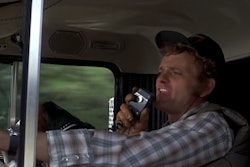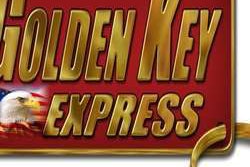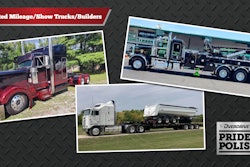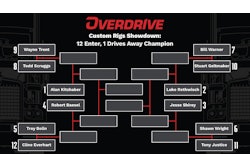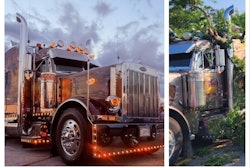This conversion from the Chrome Shop Mafia features custom spade-shaped gearshift knobs for the twin sticks, custom color-matched twin Bostrom seating and lots and lots of color-coded red and black upholstery. Note that the windows have been chopped to make them shorter, too.
Let’s face facts: The latest tractors, while clearly durable and efficient, cost a little more to run. EGR comes with a slight fuel-consumption penalty, and the latest reports from the road indicate late model trucks that don’t work hard enough burn a little extra fuel to keep the DPF cleaned out.
That only increases the appeal of pre-2002 iron, if it’s right for what you do and not too long in the tooth in the miles department. But what do you do if you’re just plain bored with your cab or, perhaps, your spouse has joined you on the road and you need better living arrangements? The answer could well be upgrading the interior of your cab and sleeper.
Just plain maintenance
An older vehicle that’s clean and sharp always seems a lot newer and more inviting than one that’s dirtied up. And upholstery always seems to be the first interior part to get ugly from use, given the types of materials used and the fact that the seats and occupants are in continuous contact while on the road. “Keeping upholstery clean is best, so no harsh cleaners need to be used. Clean often with less harsh cleaners,” says Elwin Eash, senior vice president of sales at custom sleeper manufacturer ICT in LaGrange, Ind.

The type of cleaner used makes a difference, concurs Bryan Martin, Chrome Shop Mafia bossman of 4 State Trucks in Joplin, Mo. “Develop common sense about upholstery cleaning. Don’t use anything petroleum-based or with any harsh chemical as its base.” While Windex or 409 will work “outside the truck,” he says, for interior detailing use a product designed for such.
Martin says real leather “is not as forgiving as simulated leather and vinyls as far as cleaners go. A general-purpose interior cleaner might be OK. But you might want to try such a product on a very small area, preferably a corner, behind the passenger seat first to see how it works if you have reservations.”
You can get appropriate leather cleaners and conditioners at all the major auto-supply shops. In addition, “the kind of conditioner needed for a baseball glove or cowboy boots should be applied periodically,” Martin says. “It will keep leather seats pliable so they won’t crack from cold temperatures.”
If the cleaning gets tough, be careful, Eash says, and “certainly, stay away from bleaches and harsh cleaners as they can actually remove dye colors.”
The toughest-to-clean stains come from nicotine, Martin says. “It discolors the upholstery and puts a film on it, too. This is the one time you might want to use a very strong cleaner, normally a powerful solvent, on synthetic materials only. You could use a special upholstery cleaner on seats or the dash or an aggressive shampoo on rugs. You’ll have to spray it on and let it soak first. You then may also have to scrub really hard to get the stains off.”
Picking a quality upholstery shop
Both our sources were clear on one thing: A quality shop will be happy to have their customers do their selling for them.
“Get referrals,” Martin says. “Ask the shop to give you contact information for three customers. Ask them if they can show you photos of their work, too. Do they have a guarantee? Anything we do, we apply a one-year warranty on both workmanship and materials. If it fails within one year, we will re-cover it with a different material we feel will be more durable. We’ll keep doing this until you are satisfied. Most good shops will give you a similar guarantee. And that includes having the job look the way you intended when it’s finished. Get yourself some peace of mind by getting a guarantee.”
A good baseline for a shop’s quality is how long they’ve been in business, Martin says. “Proceed with caution with a new, un-established shop. And be especially careful about getting a guarantee with a new business.”
Eash adds that a successful business that develops a good reputation soon develops the resources to promote itself aggressively. “Most reliable shops will display at shows and advertise,” he says. So it may be smart to use somebody you have read about and perhaps even talked to at a major industry event.
Changing colors and modifying an interior’s appearance
A quick and easy way to improve the appearance of your cab interior is changing the color. But this is just a surface fix if there are scratches or dents. “Color changes can be accomplished by replacing or applying a dye,” Eash says. It’s pretty simple and inexpensive to do, he adds, but “scratches and so forth that were there can still be seen.”
Naturally, the next step is getting worn-out upholstery replaced with something similar or even a different color or upgraded material. Upholstered parts that can often be upgraded by replacing this material include cab door panels, the headliner in the cab, the sleeper walls and the headliner in the sleeper. Both 4 State and ICT offer not only replacement with a similar material, possibly of a different color if you’re tired of what you have, but also exotic upgrades with unusual custom treatments. For example, 4 State offers two-tone designs in such colors as silver and black that look nothing like typical original equipment.
If you decide to do more than just recolor or replace existing upholstery, the sky is the limit. Eash says new floors are a favorite starting point at ICT. The most popular is a wooden floor, and many designs are available.
“You need a smooth sub-floor to start with,” he says. “That is installed and screwed down. Then our technicians put down wooden strips and fasten them to the sub-floor with a powerful adhesive. It ends up looking like the wooden floor in a house.”
Such flooring generally looks better when installed by trained technicians, and Eash’s company has five specially trained people doing that kind of work. You also can get Linoleum floors.
Another popular approach, Martin says, is matching the upholstery to a “fancy paint treatment that’s on the outside of the truck. A truck owner might say, ‘I want black and silver with a maroon accent in order to blend exterior and interior colors and complement the present colors of the truck.’ A recent trend is to replace existing rubber floormats or carpet with an aluminum panel that covers the floorboards. We’ll then put a Peterbilt or other truck brand logo, or your company name, on it, too.” A typical scenario is upgrading an interior just before the truck hits a particular show or truck beauty contest.
Asked which truck brands seem to get the most attention, Eash says his customers don’t discriminate. “All truck brands can be worked on for these additions. Obviously, the larger sleepers allow for more additions and features.”
Martin says his shop most frequently works on Peterbilt, Kenworth and Freightliner rigs. “Peterbilt and Kenworth are No. 1 and No. 2, the Camaro and Mustang of trucks, when it comes to customization, with Freightliner not far behind,” he says. “Those are the brands we work on most, but we also see lots of Volvos, Western Stars and Internationals. Those who run the trucks that see the most customization work are at an advantage because the aftermarket makes more products for the most popular conversions.”
Adding features
Whether it’s greater livability or more utility you want, many options are available. Martin says, in addition to prettying up everything from the rugs to the toggle switches and steering wheel, 4 State installs GPS units, radios and stereo sound systems. All kinds of custom fabrication are available, too. You could, for example, have them make a special glove-box door. Another angle is to find something unique in a salvage yard and have it polished up or custom painted and installed. With 65 employees, the 4 State staff “will hit the truck owner with ideas to see what he might like to do, because we have a passion for this kind of work,” Martin says. “We care about their needs. Because this kind of one-of-a-kind work costs money, we’ll be happy to do it in stages. Often one piece at a time is the way to do it so they can plan and control the cost so it will fit their budget.”
Eash says ICT “adds features to existing sleepers. We call it a ‘conversion.’ These may be storage cabinets, appliances like TVs, microwave ovens and sound equipment.” They will even add showers to a larger OEM sleeper, or a special item called a gaucho bed – a bunk that folds up out of the way and includes a table, which then comes down to replace it, giving you a dinette inside the sleeper.
Custom cabinets are a favorite item that can be attached securely to the structural members in the sleeper walls or, in some special designs like the T2000 composite design, to the floor, since structural members are not present. Another favorite is a flat-panel TV to save space, and related items include surround sound, satellite TV systems, Internet in motion or even a total business office. Complete kitchens including a two-burner stove are available, too.
You can even have a toilet installed. Some designs have a small, flushable collection container, while others feature large collection tanks accessible via a door from outside. These can be emptied at many truckstops after you drop your trailer.
For more information:
4 State Trucks
http://www.4statetrucks.com/
(888) 875-7787
ICT
http://www.trucksleeper.com
(800) 800-3244




